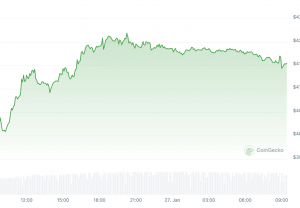Cryptocurrency
Iran shows it can unleash its own deadly drone war against US troops
Photo by Morteza Nikoubazl/NurPhoto via Getty Images
- Iran and its militia allies showed they have the suicide drone technology to defeat US air defenses.
- The drone struck Tower 22 near Jordan’s border with Syria on Sunday, killing three US troops.
- “We are now at a point where major change is needed in military thinking,” a drone expert said.
American combat drones have hunted militants and their leaders for over two decades, key weapons that established America’s primacy across vast swaths of the Middle East. But this deadly threat is no longer the exclusive preserve of US forces.
In its Sunday attack on a US outpost in Jordan, Iran and its militia allies showed they have the suicide drone technology to defeat US air defenses. The drone struck Tower 22 near Jordan’s border with Syria, killing three US service personnel and injuring over 40. The White House promptly blamed “radical Iran-backed militant groups operating in Syria and Iraq” in a statement.
“We are now at a point where major change is needed in military thinking to ensure the US and its allies can protect interests and ensure military effectiveness in an age of contested airspace,” James Rogers, an expert on drones and precision weapons, told Business Insider.
Iranian industry is now churning out advanced drones like the Shahed, used to terrifying effect by Russia in its Ukraine invasion, and Tehran is also sharing some of these systems with its so-called “Axis of Resistance” militia network across the region to upset American power.
“As Iran has spread around its drone technology, it has (rather too generously) shared it with Axis of Resistance forces in Iraq, Yemen, Syria, and Lebanon,” Arash Azizi, senior lecturer in history and political science at Clemson University and author of The Shadow Commander: Soleimani, the US, and Iran’s Global Ambitions, told Insider.
“But this has spread the dangers of confrontation since these forces don’t operate under a simple Iranian command and have a degree of autonomy,” Azizi said. “The recent pace of attacks by Houthis in Yemen and now by Iraqi militias (which also operate on Syrian territory) doesn’t seem to be in close coordination with Tehran.”
Azizi said he believes that “emboldened Iraqi militias,” who are more frequently targeted in US retaliations than Iranian agents, have stopped respecting the “usual rules of engagement” between the US and Iran in recent months as Iran’s militia network has increased its attacks.
While the militias remain “loyal to Iran” and act under the general guidance from Tehran’s powerful Islamic Revolutionary Guard Corps, Azizi underlined that the IRGC “doesn’t have day-to-day command over their actions.” Furthermore, the militias don’t always coordinate their responses to developing events with Iran.
Planet Labs PBC/Handout via REUTERS
Sunday’s attack wasn’t the first time these militias have used such drones against American troops.
On Oct. 26, another drone launched by militants evaded US air defenses at their base in Erbil, Iraqi Kurdistan, and crashed into a barracks but failed to explode. If it weren’t for that malfunction, the US could have suffered fatalities much earlier.
Rogers, the drone expert, said that the US assassination of IRGC Quds Force commander Qassem Soleimani by a Reaper drone in January 2020 was a watershed moment.
“Not only have US military and diplomatic sites been targeted at an increasing rate since the killing of Soleimani, but due to the unchecked proliferation of drones, the number of groups able to conduct such attacks has grown,” Rogers said.
“The drone was deployed at the same time as a returning US military drone, allowing it to approach undetected,” Rogers said. “Drones used by these groups, such as the Samad or Shahed, are deadly due to their range of almost 2,000 km and pin-point precision lethality. Drones like these are, in essence, state military-grade weapons systems.”
The killing of American troops put more pressure on the Biden administration to respond forcefully. Following earlier attacks injuring American personnel, the US retaliated with airstrikes, including one killing an Iraqi militia leader in Baghdad and others against militia facilities on Jan. 4 and Jan. 23, respectively.
Ceng Sagnic, chief of analysis of the geopolitical consultancy firm TAM-C Solutions, said a spate of attacks across the region by Iran-backed groups shows US efforts to contain Iran are struggling and that US retaliation is more likely to strike back at these groups rather than directly into Iran.
“These are not actions taken by a pressured, near-contained actor,” Sagnic said. “Iran-backed militias definitely crossed a line and are likely to get a harsh response from the US.”
The US does not “need to look for significant Iranian assets anywhere farther than a few kilometers from its embassies and consulates” in the region, Sagnic continued.
“If Washington decides to retaliate against Iran itself, Iraq has a lot of targets to offer.”.






